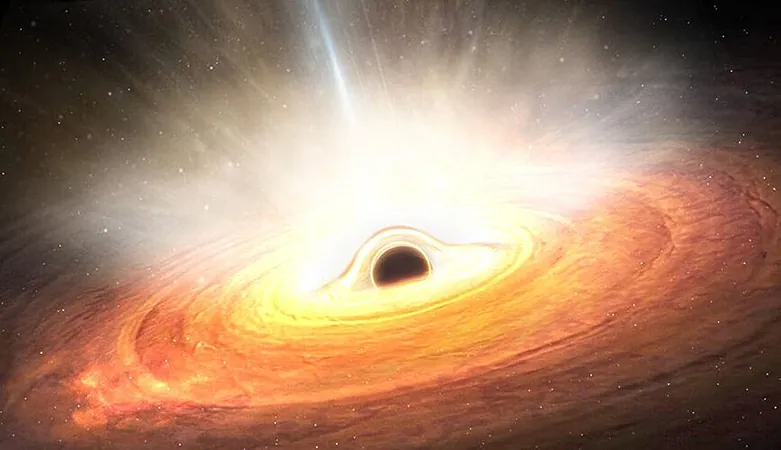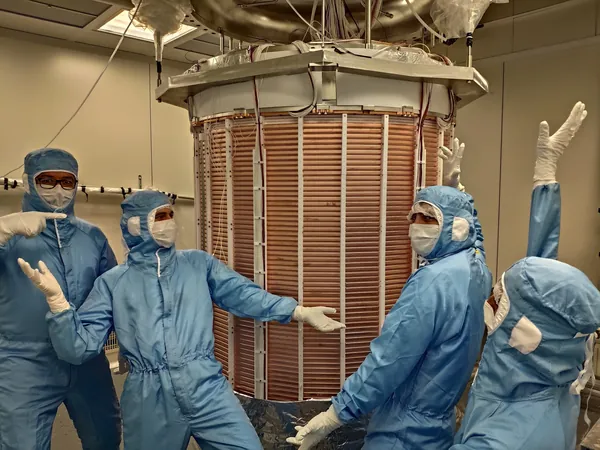
Unraveling the Cosmic Mystery: How Did Supermassive Black Holes Become Colossal So Soon?
2024-11-12
Author: Emily
Introduction
Supermassive black holes (SMBHs) are titanic structures in the universe, boasting masses that can rival billions of suns. Recent observations from the James Webb Space Telescope (JWST) have unveiled astonishing truths about these cosmic giants, sparking major questions in astrophysics.
The Early Discovery
The JWST has pushed the boundaries of our understanding by peering back into the early cosmos, capturing galaxies formed within the first billion years after the Big Bang. What scientists have discovered is surprising: SMBHs existed much earlier than previously thought and were already incredibly massive. This revelation challenges existing theories that struggle to explain how such immense black holes could form in such a short timeframe after the universe's infancy.
The Paradox of Formation
So, how did these colossal black holes achieve such massive sizes so quickly?
Black holes generally come in several categories: stellar-mass, intermediate-mass, and supermassive ones. Stellar-mass black holes form from the collapse of massive stars, while their larger counterparts, SMBHs, are believed to be involved in complex processes that include mergers of smaller black holes. However, the timeline of the early universe poses a significant challenge—there simply wasn't enough time for these mergers to occur frequently enough to create SMBHs by the time visible structures began to emerge.
Quasars and Early Masses
The JWST's findings reveal quasars powered by black holes with masses ranging from 1 to 10 billion solar masses just 700 million years post-Big Bang, casting doubt on our current understanding of black hole formation.
A New Theory: Primordial Black Holes
To tackle this cosmic puzzle, researchers, led by Francesco Ziparo of the Scuola Normale Superiore di Pisa, have proposed a groundbreaking theory: Primordial black holes (PBHs) as the seeds of early SMBHs. This theory suggests that in the dense conditions of the early universe, regions of subatomic matter could collapse directly to form PBHs before any stars existed, leading to the formation of massive black holes.
Model Explanation
According to Ziparo and his co-authors, PBHs would cluster in the same areas where dark matter halos originated. Their model emphasizes the process of PBH accretion, feedback from gas dynamics, and the evolution of dark matter to explain how these primordial seeds could evolve into the SMBHs observed by JWST. In this framework, PBHs, each about 30 solar masses, would inhabit the centers of dark matter halos. As they accumulate matter, they undergo runaway collapse, leading to the emergence of SMBHs.
Potential for Future Research
An exciting twist to this research is its potential to be tested. The authors note that during the formation phase of these primordial seeds, PBH mergers are expected to produce gravitational waves—ripples in spacetime that can be detected by future observatories. The proposed Einstein Telescope, a project aiming to enhance the sensitivity of gravitational wave detection, could soon provide empirical evidence to support or refute this new model.
Conclusion
The Einstein Telescope represents a significant advancement in our ability to study the universe via gravitational waves, which can offer insights into the evolutionary history of black holes and more broadly, the universe itself. Such observations could illuminate longstanding mysteries surrounding the formation and distribution of matter on a cosmic scale.
As we strive to comprehend the nature of SMBHs, their existence in the early universe points to a deeper understanding of cosmic evolution. The discovery that these massive structures appeared far earlier than expected presents an exciting frontier in astrophysics, challenging our current models and inviting further exploration into the cosmos's enigmatic origins. Stay tuned as researchers continue to unlock these profound secrets of the universe!









 Brasil (PT)
Brasil (PT)
 Canada (EN)
Canada (EN)
 Chile (ES)
Chile (ES)
 España (ES)
España (ES)
 France (FR)
France (FR)
 Hong Kong (EN)
Hong Kong (EN)
 Italia (IT)
Italia (IT)
 日本 (JA)
日本 (JA)
 Magyarország (HU)
Magyarország (HU)
 Norge (NO)
Norge (NO)
 Polska (PL)
Polska (PL)
 Schweiz (DE)
Schweiz (DE)
 Singapore (EN)
Singapore (EN)
 Sverige (SV)
Sverige (SV)
 Suomi (FI)
Suomi (FI)
 Türkiye (TR)
Türkiye (TR)